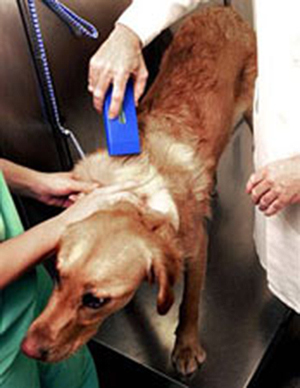
April is home to several well-meaning pet holidays, aimed at either increasing animal rights and safety awareness or your pet-induced smiling quota for the month. For starters in lifting our paws of praise, April is officially designated Prevention of Cruelty to Animals Month, thanks to the American Society of the Prevention of Cruelty to Animals.
As the first humane society established in North America and one of the first granted the ability to investigate and make arrests for crimes against animals, the ASPCA is a true backbone in providing guidance, resources and opportunities for us all to engage in protecting the lives of animals. They offer several different opportunities for you to show your support and help end animal cruelty this month on their website. One hot topic perking our little ears up more and more these days in the conversation of animal cruelty is animal tattooing.
Since April is also the month our Dog Tag Art crew rejoices in for National Pet Identification Awareness, let’s discuss pet identification methods, animal tattoos, micro-chipping and pet id tags.
|
Pet Tattoos: The word "pet" and "tattoo" may not go together for most pet owners. The issue of tattooing your pet is one that continues to be discussed in very different realms: one form strictly for pet identification used by veterinarians and human societies and the other strictly for body art and pet vanity. Let's break down these two sides of the coin and discuss why pet tattoos can be a useful concept as well as a an unecessary one. |
 |
• Pet Tattoos for Pet Identification: Each state’s humane society has its own rules and regulations however, the majority tattoo pets after a spay/neuter and microchip procedure. The tattoo is typically around the size of two grains of rice and is inscribed on the incision where the microchip was placed. A microchip and tattoo show actual title or ownership to an animal in a traditional property law sense, according to the Animal Legal and Historical Center. So, when an animal is tattooed, its ID number is then registered with that state’s department of agriculture and also engraved on the little tag they give you for Dixie’s collar, which can be transferred to another state if/when the pet, and owner move. Paws up for that!
• Pet Tattoos for Art: This is where things get well…weird. We completely understand the use and need for pet identification tattoos for safety precautions. One thing we can’t wrap our paws around is why anyone feels compelled to ink a portrait of Marilyn Monroe on their pit bull’s belly. We’ve read the petitions in response to social media posts of some who have, with reactions ranging from, “Well I sedated him so he didn’t feel it and it’s on par with a visit to the vet or groomer” to “Now I’ll know she’s mine if I lose her and need to pick her up”. The cases have gotten so out of hand that New York banned pet tattooing and piercing in December of 2014. Sigh. We definitely opt for something like the ‘Born to Be Loved’ pet id tag instead.
|
Pet MicroChipping: The technology and practice of pet microchipping has been around for over a decade now. A microchip is a small electronic chip housed in a glass case about the size of a grain of rice, which is activated by a scanner and is then able to be read in the case of an emergency via x-ray and scanners. They’re easily placed using a hypodermic needle in one shot and essentially painless for your pet. The American Veterinary Medical Association answers any other questions you may have regarding microchip information, the information contained and how your pet’s chip translates in other countries for travel/moving. “Microchips are great for permanent identification that is tamper-proof, but nothing replaces a collar with up-to-date identification tags. If a pet is wearing a collar with tags when it's lost, it's often a very quick process to read the tag and contact the owner; however, the information on the tags needs to be accurate and up-to-date. “ ~American Veterinary Medical Association |
 |
One major point to note is that “there is no federal or state regulation of microchip standards in the U.S., and different manufacturers are able to produce and patent different microchip technologies with different frequencies,” according to the AVMA. When deciding to microchip your pet, be sure to understand the difference between the various types of chips out there and which are the most common and therefore offer your pet the most protection for the area home state. We also recommend keeping an up-to-date pet id tag along with your microchip which leads us to our next and method and most traditional area of pet identification: pet id tags.
| Pet ID Tags: A pet ID tag is the most basic and traditional form of pet identification and is not at all made unnecessary by microchipping and other advances in pet technology. Our neighbors certainly don’t own pet scanners so the easiest way for your excited little adventurer to get home safely is by wearing an up-to-date pet ID tag on their collar. “Approximately 7.6 million companion animals enter animal shelters nationwide every year. 649,000 of the animals who enter shelters as strays are returned to their owners and 2.7 million euthanized,” according to the ASPCA. It is statistics like this that led our company to the founding of Dog Tag Art back in 2009. With stray animals accounting for over half of the animals typically being brought into shelters and humane societies, the important work of sharing why every pet needs an updated pet ID tag is still needed more than ever. |  |
Here at Dog Tag Art, we also understand that one phone number and your home address don’t always cut it. What if Buster has medical conditions or what if Aunt Paulina lives right around the corner? To create the ultimate tag, we added ‘Virtual Leash’ technology to our tags, an option for you to create an online profile for your pet with medical and additional contact information for your little one. A link is then added to the back of your pet’s tag so that when they’re found, the precious finder of your best bud can log on and instantly have all of the information to get them back to you with tongue out and tail still waggin’.
This April 19-25 as we celebrate National Pet ID Week, check to make sure your pet’s tag has their current doghouse address and telephone number.
Tiffany Narron is the two-legged keeper of her beloved 11-year-old Australian Shepherd Bella Blue. While Bella isn’t microchipped, she keeps Bella’s tag up-to-date as she moves around exploring different parts of Asheville, NC. Bella’s current pet ID tag is one honoring Frida Kahlo, their shared role model.

